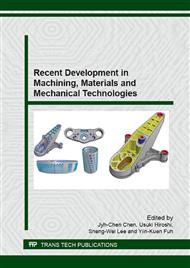p.226
p.231
p.237
p.243
p.251
p.255
p.261
p.266
p.271
Effects of Guide Groove Shape on Chip Controllability for Chip-Guiding Turning
Abstract:
Conventionally, chip breakers are utilized for efficient chip disposal, where the chip is assisted to curl up and broken into pieces. However, this approach may not work effectively in cutting of highly-ductile materials such as low-carbon steels or heat-resistant alloys. The problem of chip jam may frequent occur especially in finishing operation, since the chip is thin and flexible [1]. In order to suppress chip-jam, the authors have proposed a new method, called the ‘chip-guiding turning’ [2]. Fig. 1 shows the concept of chip-guiding turning briefly. In this method, instead of breaking the chip, it is continuously guided to a desired direction for continuous disposal.
Info:
Periodical:
Pages:
251-254
Citation:
Online since:
July 2015
Authors:
Keywords:
Price:
Сopyright:
© 2015 Trans Tech Publications Ltd. All Rights Reserved
Share:
Citation:


